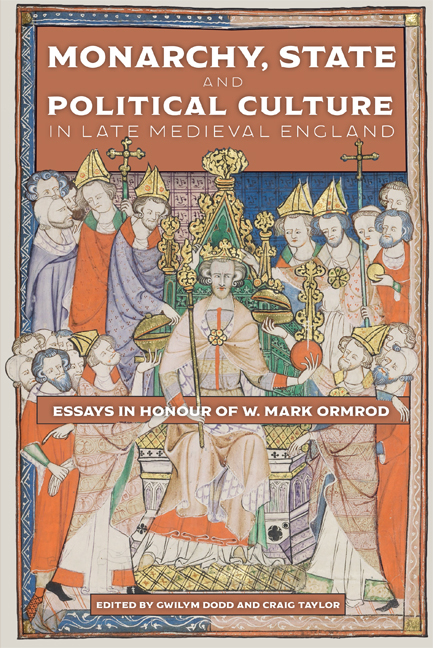Book contents
- Frontmatter
- Contents
- Frontispiece
- Preface and Acknowledgements
- Contributors
- Abbreviations
- Professor W. Mark Ormrod: A Personal Appreciation
- 1 The ‘Unfortunate’ Fraudster: Thomas de Boulton and the East Riding Lay Subsidy of 1332
- 2 Negotiating and Creating Collegiate Statutes in the Fourteenth Century
- 3 An Emotional Pragmatism: Edward III and Death
- 4 Defaming the King: Reporting Disloyal Speech in Fourteenth-Century England
- 5 Law and Arms: The Politics of Chivalry in Late Medieval England
- 6 ‘Nother by Addicions, Nother by Diminucions’: The Parliament of April 1414 and the Drafting of Late Medieval English Legislation
- 7 The Medieval ‘Side-Hustler’: Thomas Hoccleve’s Career in, and out of, the Privy Seal
- 8 The Order, Rules and Constructions of the House of the Most Excellent Princess Cecily, Duchess of York
- 9 Archbishops’ Registers Revealed: Church, State and Society in the Registers of the Archbishops of York, 1225–c.1650
- List of PhD Supervisees
- List of Grants
- Index
- Tabula Gratulatoria
1 - The ‘Unfortunate’ Fraudster: Thomas de Boulton and the East Riding Lay Subsidy of 1332
Published online by Cambridge University Press: 06 October 2020
- Frontmatter
- Contents
- Frontispiece
- Preface and Acknowledgements
- Contributors
- Abbreviations
- Professor W. Mark Ormrod: A Personal Appreciation
- 1 The ‘Unfortunate’ Fraudster: Thomas de Boulton and the East Riding Lay Subsidy of 1332
- 2 Negotiating and Creating Collegiate Statutes in the Fourteenth Century
- 3 An Emotional Pragmatism: Edward III and Death
- 4 Defaming the King: Reporting Disloyal Speech in Fourteenth-Century England
- 5 Law and Arms: The Politics of Chivalry in Late Medieval England
- 6 ‘Nother by Addicions, Nother by Diminucions’: The Parliament of April 1414 and the Drafting of Late Medieval English Legislation
- 7 The Medieval ‘Side-Hustler’: Thomas Hoccleve’s Career in, and out of, the Privy Seal
- 8 The Order, Rules and Constructions of the House of the Most Excellent Princess Cecily, Duchess of York
- 9 Archbishops’ Registers Revealed: Church, State and Society in the Registers of the Archbishops of York, 1225–c.1650
- List of PhD Supervisees
- List of Grants
- Index
- Tabula Gratulatoria
Summary
OF ALL THE MANY AND VARIED sources available to late-medieval historians, few have proved as useful, or as controversial, as the records of central government taxation. These records, with their long lists of taxpayers and the sums they paid, generally arranged by parish or township within hundreds and counties, have long been a staple source of information and insight. For genealogists and family historians, they can provide a rich source of names, particularly in the early-modern period, showing where people were living at particular times and, where the records survive, allowing generations of families to be traced over time in a particular place or region. For local historians, they provide snapshots of places at specific points in their history and development, giving at least some idea of the local population, the wealth of the place, and how settlements expanded, contracted, and in some cases disappeared entirely. For economic and social historians, for whom the specific individual details are generally less important than the wider picture, these documents can give insights into issues such as the relative sizes of the populations of places over time, and their actual and relative wealth and economic prosperity. And these records can also be used to study broader topics, such as the mobility of the medieval population, with the topographical surnames listed in these records giving strong indications of the origins of taxpayers or their ancestors, whether from neighbouring towns and villages, other parts of England, or overseas.
Historical and antiquarian societies, conscious of the huge amounts of information contained in such records, have been only too keen to publish transcribed taxation lists in their volumes. They provided a regular source of material for Victorian journals, and various national and local societies continue to publish editions to this day. For instance, between 1998 and 2005, the British Academy published Carolyn Fenwick's monumental editions of the extant records of the fourteenth-century poll taxes, and as recently as 2014, the Hampshire Record Society published an edition of the 1327 lay subsidy assessment for that county. The Centre for Hearth Tax Research at the University of Roehampton has also edited and published large numbers of documents from that tax from the late seventeenth century, as well as using the returns to produce various studies based on the information they contain.
- Type
- Chapter
- Information
- Monarchy, State and Political Culture in Late Medieval EnglandEssays in Honour of W. Mark Ormrod, pp. 1 - 20Publisher: Boydell & BrewerPrint publication year: 2020

